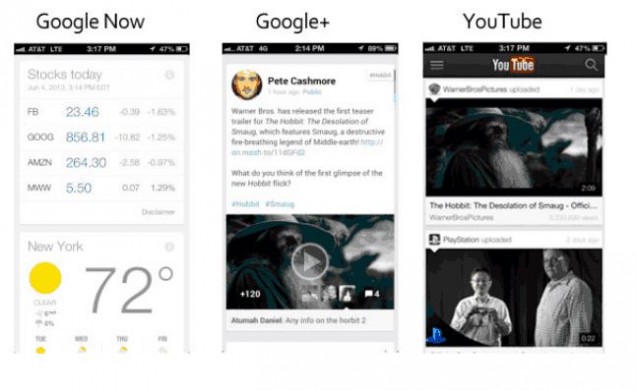10 blue links. This is how search engines currently answer questions — over a billion times each day. But what if instead of seeing 10 results, you only saw one? Sounds crazy, I know. But search is evolving and this could be its future. And it could be here a lot sooner than you think. Let’s take a look at why.
The Next Evolution of the SERP
We’re all familiar with the big algorithm updates like Panda and Penguin that happen a few times each month, but sometimes we forget that user interface changes can impact click through rate and traffic. This is important to keep in mind, as the actual look and feel of search could be changing drastically. In fact, the next evolution of the SERP could come from a new format called info cards.
While it might be difficult to fathom that info cards could replace the ubiquitous blue links, it’s actually quite plausible — especially when you consider how Google is displaying information in some of their latest products which we’ll explore below.
What Are Info Cards?
Info cards are small, dynamic widgets tailored to show specific information, like the weather, sports scores, or your friend’s status updates. Info cards are not exclusive to Google (see Twitter’s version with their Tweet Card), but they use them heavily in their mobile products like Google Now, Google+ and Google Glass.
The info card format across a few of Google’s mobile products:
Google also uses them to display information in Google Glass:
Many info cards, such as facts about people, places and things, are primarily powered by Google’s Knowledge Graph, which pulls information from Google owned properties like Google+ and Freebase, as well as trusted outside sources like Wikipedia.
Much like a deck of playing cards, info cards stack on top of one another, allowing users to swipe through to the next card, which circumvents the limited screen space on smart phones and Glass.
Given their design, I’m sure you can imagine how these cards might be used to deliver search results. Info cards would have an incredible impact on brands, as searchers would ONLY see the top result at first!
What’s Behind the Big Shift Away From 10 Blue Links
But the potential shift away from blue links to info cards is about a lot more than a makeover of the search results. The real value of info cards lies in the deep personalization Google is building into them.
While hardly a new product, Google Now is paving the way for their deep search experience by delivering information based on your life, not keywords. For example, as I leave my house Google may recommend I take an umbrella if it looks like rain, or an alternate travel route if there is a traffic jam up ahead.
To make these recommendations Google must have access to your email, calendar, location and travel history. For most companies, this would be an impossible task, but with Google’s vast array of products they can easily get this information and much more.
Now consider how this data might be used to enhance a common search such as one for “new car.” Today, a normal search for this term might return several paid listings and 10 organic listings that cover car reviews, videos, manufacturer websites, and local car dealers.
But if you were to layer-on a level of deep personalization, that same search might factor in the following: how far you drive to work, how many kids you have, what cars your friends drive, what car photos you’ve looked at online, current dealer incentives, local dealer inventory, price range based on recent spending habits, best insurance rates, and even your favorite color.
The end result? That search would return an info card with a single car perfectly tailored to who Google thinks you are based on their in-depth user profile.
The Need for a Different Kind of Optimization
While much of the information Google needs to deliver this level of personalization can be found online, some of it — such as inventory levels and insurance rates — would be hard for them to get by simply crawling a Web page. Ultimately they will need a real-time feed of information that they can pipe into their Knowledge Graph.
Because of that, SEO would extend beyond optimizing Web pages to optimizing information feeds. What’s more, the actual optimization itself would change too — from optimizing for keywords that people search for, to optimizing for attributes and behaviors that match consumer profiles.
If this future plays out as described above, SEOs will be responsible for helping search engines make the connection between product data and consumer profiles.
For instance, Volkswagen may be able to provide search engines with a list of specs on their new Beetle TDI, but the search engines may not understand that “clean diesel” really means a fuel efficient, environmentally-friendly car. SEOs will need to provide that context by adding additional information, such as the class of car, awards that highlight its fuel efficiency, and links to topical Web pages that discuss the car’s environmental impact.
The point here is that SEOs will be responsible for filling-out Google’s Knowledge Graph so that the attributes of a product meet the real life needs of a consumer.
3 Tips to Prepare for the Next Evolution of Search
Below are a few things you can start doing today to get ready for the change:
1. Focus on Consumer Behavior: Invest in the tools and resources needed to understand consumer behavior. Last year Target made the news for knowing when a teen girl was pregnant before her father found out. Companies like Target are in an excellent position to rank well in the future, because their products are already mapped to real-life user behavior.
The first step to building consumer profiles is get some basic information about who your users are such as age, gender and location. There are a few simple ways to get at this data:
- Ask them – Conduct a customer survey, let users create profiles on your site, or add a few optional fields during your checkout process.
- Use social networks – When a user creates an account on your site, ask them to do it through Facebook, LinkedIn or Twitter. You’ll receive a ton of great information such as contact information, location, age, gender, personal interests, number of friends, and most importantly, the ability to post to that user’s timeline (provided they give you permission).
- Use 3rd parties to enhance data – Companies like Acxiom and Experian will take basic user information such as name, email and address, and will overlay it with in-depth profiling data such as household size and income.
Tip: If you have a segment of users that are considered “high value,” you can send that list to Facebook, and they can create a look-a-like group based on similarities to your given segment. That look-a-like group can be setup as a custom audience inside Facebook’s advertising system to help you acquire new users who resemble the high-value segment you already have. parties to enhance data – Companies like Acxiom and Experian will take some
2. Build Consumer Intimacy
The future of search will be about optimizing for a consumer rather than a keyword. Given that, it is important to focus on creating better/more intimate relationships with them. But many brands make the mistake of spending money to build a huge base of fans without building intimacy. They built an audience to broadcast messages to, like a speaker delivering a speech to a large crowd. Now they’re finding out that it’s really hard to create intimacy this way. So in essence, they’ve shot their SEO efforts in the foot trying to keep up with the Jones’ follower count.
Keep in mind that Google+ will play an important role in the future SERPS, not only because it acts as an ID system for searches, but because Google can map-out the depth of a relationship between a user and a brand. The stronger the relationship, the greater the trust will be, and the better the search experience.
3. Prepare for The Knowledge Graph
Today the Knowledge Graph is largely based off Freebase, Wikipedia, and a few other sources. Studying the structure of Freebase will give you clear insight into how Google wants its data structured for the Knowledge Graph.
Google is taking steps to better structure Web pages as crawling them is a very inefficient process, as far as data capturing goes. It’s much more effective to send data through an API or product feed. With that in mind, spend time familiarizing yourself with microdata, Freebase, and other structured data sources Google uses. It will make the transition process much easier once Google opens up the Knowledge Graph to more outside sources.
The Future of Search is on Its Way. Are You Prepared?
If Google flipped the switch tonight from 10 blue links to info cards, how would you fare? Would you know what product attributes match your target consumers? Do you have a grasp of structured data, and a process for exporting your product information into a useable feed? Have you built real relationships on Google+ and other social channels? If not, you might want to start. Today.
How well prepared are you for the future of search results? What steps have you taken to get ready for the next evolution in search?
image credit: Shutterstock







